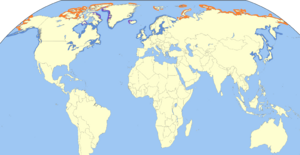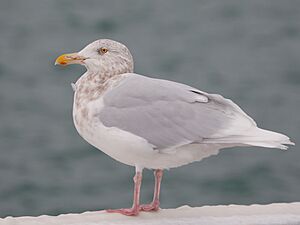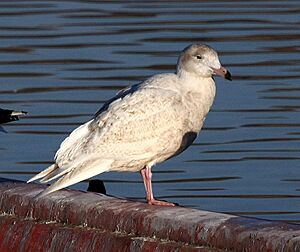Glaucous gull facts for kids
Quick facts for kids Glaucous gull |
|
|---|---|
 |
|
| Conservation status | |
| Scientific classification | |
 |
The glaucous gull (Larus hyperboreus) is a very large gull. It's actually the second-biggest gull in the whole world! Its name, "glaucous," comes from a Latin word that means "grey." This fits because the gull is mostly pale grey. The other part of its scientific name, hyperboreus, means "northern." This makes sense because these gulls live in cold, northern places. Some people used to call this bird the burgomaster.
Contents
Where They Live
These gulls make their nests and have their babies in the very cold Arctic areas of the Northern Hemisphere. When winter comes, they fly south to warmer places. They travel across the North Atlantic and North Pacific Oceans. You can find them as far south as the British Isles and the northern parts of the United States. They also visit the Great Lakes. Sometimes, a few glaucous gulls even fly all the way to the southern USA and northern Mexico.
What They Look Like
The glaucous gull is a big, strong bird. It's the second-largest gull species on Earth. These gulls are very pale all over, with no black feathers on their wings or tail.
Adult glaucous gulls have pale grey backs and wings. They also have a thick, yellow beak. Young gulls are a very pale grey. Their beaks are pink with a black tip.
This gull is much bigger and stronger than the similar Iceland gull. It can even be as big as the great black-backed gull. Some glaucous gulls can weigh from about 2 pounds (960 grams) to almost 6 pounds (2,700 grams). Their wings can spread very wide, from about 4 feet (132 cm) to over 5.5 feet (170 cm). Some very large ones might even reach 6 feet (182 cm)! It takes these gulls four years to grow into adults.
Their call sounds like a "laughing" cry. It's similar to the sound a herring gull makes, but it's much deeper.
Types of Glaucous Gulls
There are four different types, or subspecies, of the glaucous gull:
- L. h. hyperboreus: This type lives from northern Europe to north-western Siberia.
- L. h. pallidissimus: This is the largest type. It lives from north-western Siberia to the Bering Sea. It is even paler than the first type and has bright pink legs.
- L. h. barrovianus: This is the smallest type. It lives from Alaska to north-west Canada. It has a slightly darker back and shorter beak.
- L. h. leuceretes: This type lives from north-central Canada to Greenland and Iceland. It is usually a bit paler than the first type.
Life and Habits
Glaucous gulls often build their nests in groups, or sometimes alone, on coasts and cliffs. They make a nest on the ground or on a cliff ledge and line it with soft materials. Usually, a female gull lays two to four eggs. The eggs are light brown with dark brown spots.
Like most gulls, glaucous gulls eat many different things. They are omnivores, which means they eat both plants and animals. Their diet includes fish, insects, and small sea creatures like mollusks and starfish. They also eat leftover food, scraps, eggs from other birds, and small birds or mammals. Sometimes, they even eat dead animals. Besides meat, they also enjoy seeds, berries, and grains.
Images for kids







